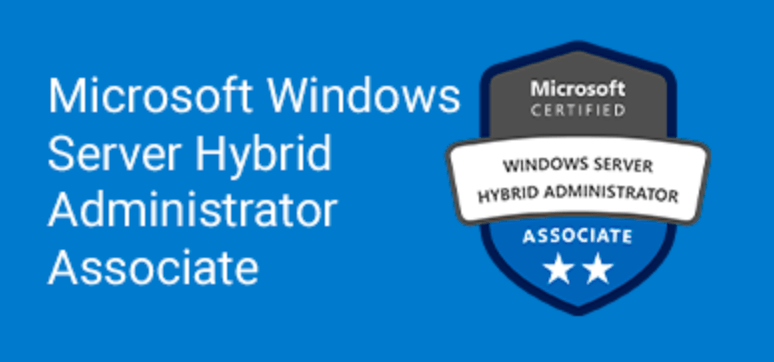
Lab: Implementing failover clustering
Scenario
As the business of Contoso, Ltd. grows, it’s becoming increasingly important that many of the applications and services on its network are always available. Contoso has many services and applications that must be available to internal and external users who work in different time zones around the world. Many of these applications can’t be made highly available by using Network Load Balancing (NLB). Therefore, you should use a different technology to make these applications highly available.
As one of the senior network administrators at Contoso, you’re responsible for implementing failover clustering on the servers that are running Windows Server to provide high availability for network services and applications. You’re also responsible for planning the failover cluster configuration and deploying applications and services on the failover cluster.
Note: An interactive lab simulation is available that allows you to click through this lab at your own pace. You may find slight differences between the interactive simulation and the hosted lab, but the core concepts and ideas being demonstrated are the same.
Objectives
After completing this lab, you’ll be able to:
- Configure a failover cluster.
- Deploy and configure a highly available file server on the failover cluster.
- Validate the deployment of the highly available file server.
Estimated time: 60 minutes
Lab setup
Virtual machines: AZ-801T00A-SEA-DC1, AZ-801T00A-SEA-SVR1, and AZ-801T00A-SEA-SVR2 must be running. Other VMs can be running, but they aren’t required for this lab.
Note: AZ-801T00A-SEA-DC1, AZ-801T00A-SEA-SVR1, and AZ-801T00A-SEA-SVR2 virtual machines are hosting the installation of SEA-DC1, SEA-SVR1, and SEA-SVR2
- Select SEA-SVR2.
- Sign in using the following credentials:
- Username: Administrator
- Password: Pa55w.rd
- Domain: CONTOSO
For this lab, you’ll use the available VM environment.
Exercise 1: Configuring iSCSI storage
Scenario
Contoso has important applications and services that it wants to make highly available. Some of these services can’t use NLB, so you have decided to implement failover clustering. You decide to use Internet Small Computer System Interface (iSCSI) storage for failover clustering. First, you’ll configure iSCSI storage to support your failover cluster.
The main tasks for this exercise are to:
- Install Failover Clustering.
- Configure iSCSI virtual disks.
Task 1: Install Failover Clustering
- On SEA-SVR2, start Windows PowerShell as administrator.
- On SEA-SVR2, use Windows PowerShell to install the Failover-Clustering feature including management tools on SEA-SVR1 and SEA-SVR2.
- On SEA-SVR2, use Windows PowerShell to install the FS-iSCSITarget-Server feature on SEA-DC1.
Task 2: Configure iSCSI virtual disks
Important: The lab uses SEA-DC1, which serves as an Active Directory Domain Services (AD DS) domain controller to host shared iSCI storage for a Windows Server-based cluster. This is not meant to represent in any way a recommended configuration but is done to simplify the lab configuration and minimize the number of lab virtual machines. In any production environment, domain controllers should not be used to host shared storage for failover clusters. Instead, such storage should be hosted on highly available infrastructure.
- On SEA-SVR2, start two more Windows PowerShell windows as administrator.
- Establish a PowerShell Remoting session to SEA-DC1 and SEA-SVR1, respectively, by using the second and third Windows PowerShell window.
- Create three iSCSI virtual disks on SEA-DC1 by using the PowerShell Remoting session to SEA-DC1 to create the C:\Storage directory and run the New-IscsiVirtualDisk cmdlet with the following parameters:
- Disk1:
- Storage location: C:\Storage
- Disk name: Disk1
- Size: 10 GB
- Disk2:
- Storage location: C:\Storage
- Disk name: Disk2
- Size: 10 GB
- Disk3:
- Storage location: C:\Storage
- Disk name: Disk3
- Size: 10 GB
- Disk1:
- Start the iSCSI initiator (MSiSCSI) service on SEA-SVR2 and SEA-SVR1 and configure it to start automatically by using the local Windows PowerShell session to SEA-SVR2 and the PowerShell Remoting session to SEA-SVR1 to run the Start-Service and Set-Service cmdlets.
- Create an iSCSI target on SEA-DC1 by using the PowerShell Remoting session to SEA-DC1 to run the New-IscsiServerTarget cmdlet with the following parameters:
- Target name: ISCSI-L03
- InitiatorsIds:
- “IQN:iqn.1991-05.com.microsoft:sea-svr1.contoso.com”
- “IQN:iqn.1991-05.com.microsoft:sea-svr2.contoso.com”
Results
After completing this exercise, you should have successfully installed the Failover Clustering feature on SEA-SVR1 and SEA-SVR2 as well as initialized iSCSI components on SEA-DC1, SEA-SVR1, and SEA-SVR2.
Exercise 2: Configuring a failover cluster
Scenario
In this exercise, you’ll prepare for cluster installation and then create a cluster.
The main tasks for this exercise are to:
- Connect clients to the iSCSI targets.
- Initialize the disks.
- Validate and create a failover cluster.
Task 1: Connect clients to the iSCSI targets
- On SEA-SVR2, mount the iSCSI disks on SEA-DC1 by using the Windows PowerShell window hosting PowerShell Remoting session to SEA-DC1, to run the Add-IscsiVirtualDiskTargetMapping cmdlet.
- On SEA-SVR2, connect to the iSCSI Target hosted on SEA-DC1 from SEA-SVR2 by using the local Windows PowerShell session to run the following commands:Code
New-iSCSITargetPortal -TargetPortalAddress SEA-DC1.contoso.com Connect-iSCSITarget -NodeAddress iqn.1991-05.com.microsoft:sea-dc1-iSCSI-L03-target Get-iSCSITarget | flNote: Verify that after you run the last command, the value for the IsConnected variable is True.
- On SEA-SVR2, connect to the iSCSI Target hosted on SEA-DC1 from SEA-SVR1 by using the PowerShell Remoting session to SEA-SVR1 to run the following commands:Code
New-iSCSITargetPortal -TargetPortalAddress SEA-DC1.contoso.com Connect-iSCSITarget -NodeAddress iqn.1991-05.com.microsoft:sea-dc1-iSCSI-L03-target Get-iSCSITarget | flNote: Verify that after you run the last command, the value for the IsConnected variable is True.
Task 2: Initialize the disks
- On SEA-SVR2, list the local disks by using the local Windows PowerShell session to run the Get-Disk cmdlet.
- On SEA-SVR2, initialize the three iSCSI disks with the following settings by using the local Windows PowerShell session:
- PartitionStyle: MBR
- New-Partition Size: 5GB
- File System : NTFS
- Assign drive letters: E, F, and G, respectively.
Task 3: Create a failover cluster
- On SEA-SVR2, create a failover cluster named SEA-CL03 with the IP address set to 172.16.10.125 and SEA-SVR2.contoso.com as the first node by using the local Windows PowerShell session.
- On SEA-SVR2, add the SEA-SVR1 as the second node to the newly created cluster by using the local Windows PowerShell session.
Results
After completing this exercise, you should have configured disks and created a failover cluster.
Exercise 3: Deploying and configuring a highly available file server
Scenario
At Contoso, file services are important services that must be made highly available. After you have created a cluster infrastructure, you decide to configure a highly available file server and then implement settings for failover and failback.
The main tasks for this exercise are to:
- Add the file server application to the failover cluster.
- Add a shared folder to a highly available file server.
- Configure the failover and failback settings.
Task 1: Add the file server application to the failover cluster
- On SEA-SVR2, open the Failover Cluster Manager console and verify that you are automatically connected to the SEA-CL03.contoso.com cluster.
- In the Nodes node, verify that both of the SEA-SVR2 and SEA-SVR1 nodes are running.
- In the Storage node, select Disks, and then verify that three cluster disks are online.
- Add File Server as a cluster role with the File Server for general use option and the following settings:
- Client Access Name: FSCluster
- Address: 172.16.0.130
- Storage: Cluster Disk 1, Cluster Disk 2
Task 2: Add a shared folder to a highly available file server
- On SEA-SVR2, in the Failover Cluster Manager console, add a file share to the FSCluster role with the following settings (leave all others with the default values):
- File share profile: SMB Share – Quick
- Name: Docs
Task 3: Configure the failover and failback settings
- On SEA-SVR2, in the Failover Cluster Manager console, use the Properties dialog box of the FSCluster cluster role to configure the following settings:
- Failback: between 4 and 5 hours
- Preferred owners: SEA-SVR2 and SEA-SVR1 with SEA-SVR1 on the top of the list
Results
After completing this exercise, you should have configured a highly available file server.
Exercise 4: Validating the deployment of the highly available file server
Scenario
In implementing a failover cluster, you want to perform failover and failback tests. Additionally, you want to change the witness disk in the quorum.
The main tasks for this exercise are to:
- Validate the highly available file server deployment.
- Validate the failover and quorum configuration for the File Server role.
Task 1: Validate the highly available file server deployment
- On SEA-SVR2, open File Explorer and verify that you can access the \\FSCluster\Docs share.
- Create a test text document in the share.
- On SEA-SVR2, use the Failover Cluster Manager console to move the FSCluster role to another node.
- On SEA-SVR2, in File Explorer, verify that you can still access the \\FSCluster\Docs share.
Task 2: Validate the failover and quorum configuration for the File Server role
- On SEA-SVR2, in the Failover Cluster Manager console, identify the current owner for the FSCluster role.
- Stop the Cluster service on the node, which is the current owner of the FSCluster role.
- On SEA-SVR2, use File Explorer to verify that the \\FSCluster\Docs share is still available.
- On SEA-SVR2, use the Failover Cluster Manager console to start the Cluster service on the node on which you stopped it in step 2.
- On SEA-SVR2, in the Failover Cluster Manager console, configure cluster quorum for FSCluster by using the default settings.
- In the Failover Cluster Manager console, browse to the Disks node and take the disk marked as witness disk in Quorum offline.
- On SEA-SVR2, use File Explorer to verify that the \\FSCluster\Docs share is still available.
- Bring the witness disk online.
Results
After completing this exercise, you should have validated high availability with Failover Clustering.

